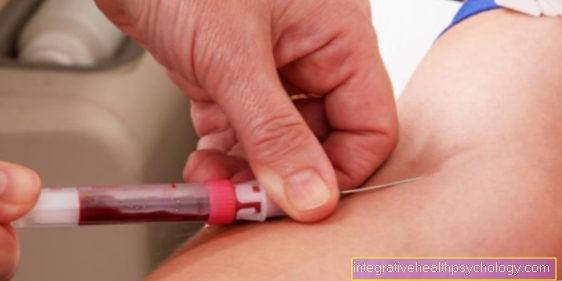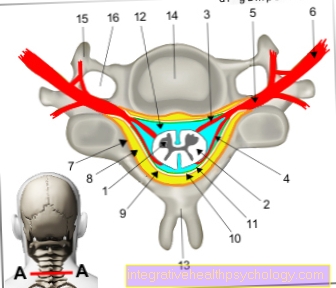Elephantiasis
What is elephantiasis?
Elephantiasis is a disease in which there is massive swelling of tissue. Typically the term is used for the end stage of a chronic lymphedema disease.
In the process, disturbances in the transport of lymph (tissue fluid) lead to permanent formation of edema (fluid deposits in the tissue).
This leads to massive swelling of the affected part of the body over time. In addition, there is a transformation in the skin, which is accompanied by a significant thickening and hardening.
Typically, the elephantiasis is found on the legs; more rarely, the arms or other parts of the body can also be affected. Characteristic of elephantiasis is its irreversibility, so the tissue remodeling can no longer be completely reversed.
In rare cases, other types of elephantiasis occur. For example, there are diseases in which skin tissue grows uncontrollably and thus leads to massive tissue accumulations in individual parts of the body (there are cases of elephantiasis on the nose or on the soles of the feet).

causes
The cause of elephantiasis is chronic, pronounced fluid retention in the tissue. The reason for this is often chronic diseases of the heart and kidneys. The heart disease weakens the circulation so that the tissue fluid can no longer be pumped back to the heart and sinks into the legs. With kidney weakness, not enough fluid is excreted, so that it collects in the body. A severe protein deficiency can also lead to edema and fluid retention. The reason for this is often a dysfunction of the liver, as less proteins are formed as a result.
Chronic edema can also result from damage to the lymphatic system. Elephantiasis usually arises from an accumulation of lymph fluid, but it can also be triggered and exacerbated by other fluids, for example due to heart and kidney diseases. Reasons for damage to the lymphatic system are injuries to the vessels after trauma or surgery. Tumors and radiation can also damage lymph vessels.
There are also pathogens that cause diseases such as leprosy and syphilis and can also lead to lymphedema.
Tropical diseases such as Wuchereria bancrofti caused by nematodes can also lead to chronic lymphedema and thus to elephantiasis. In the case of infectious diseases in particular, early therapy can bring about complete healing. If the disease is discovered or treated too late, however, irreversible damage occurs with skin changes and massive swelling, so that elephantiasis develops.
diagnosis
The diagnosis of elephantiasis can initially be carried out clinically.
The criterion of irreversibility (irreversibility) of the changes in the skin and the underlying tissue must be present so that one can speak of elephantiasis.
Much more important, however, is the diagnosis before elephantiasis occurs.
The earlier the disease of the lymphatic system is discovered, the sooner a therapy can be started to prevent the development of elephantiasis. Edema (fluid retention) should be detected at an early stage.
The danger of developing elephantiasis is present if the edema is due to diseases of the lymphatic system.
Infectious diseases, in particular, can be discovered using anamnesis, the so-called patient interview, and laboratory tests. In the laboratory, the blood is tested for antibodies against the pathogens.
For example, the pathogens can be transmitted through mosquito bites in tropical regions and later trigger diseases. The pathogens can then be detected in the laboratory.
I recognize elephantiasis from these symptoms
By definition, elephantiasis is accompanied by severe swelling of the affected body region. This is caused by chronic fluid retention.
In addition, there must be changes in the skin such as hardening and thickening.
The symptoms typically begin with a soft swelling of the tissue. This leads to edema, which is initially present on the back of the foot. If you press the skin in there for a few seconds and then remove the pressure, you leave a dent in the tissue that only recedes very slowly.
Classically, in lymphedema, which is the precursor to elephantiasis, the toes are also affected by the edema. So-called box toes develop: thickened, edematous toes.
In addition, there is the Stemmer sign, in which the skin can no longer be lifted off the toes due to the fluid retention. Lymphedema is often accompanied by a feeling of heaviness in the affected body region, usually the legs, and a feeling of tension, and pain in the affected body regions can also occur.
Due to the pronounced edema, the blood circulation becomes worse at some point, so that the body region is rather pale and cold.
Gradually changes in the skin develop, so-called fibrosis (a connective tissue remodeling of the skin) occurs, which makes the skin harder and thicker.
In the long run, the skin becomes dry and cracked, it can also turn reddish or brownish in color.
- This article might also interest you: Swollen legs
therapy
Therapy should be given before elephantiasis is present. Elephantiasis is a stage of lymphedema that cannot regress. Therefore, adequate therapy should be given beforehand.
This initially consists of conservative methods such as consistently elevating the affected body region.
Physical measures such as lymph drainage, in which the therapist presses the lymph fluid towards the heart with their hands, and compression therapy using bandages and compression stockings can also be used.
A lot of exercise also helps to improve lymphatic drainage.
If the lymphedema is based on an underlying disease such as an infection, it should be treated with antibiotics for bacteria or other antimicrobial substances (e.g. against the roundworm). This is the only way to prevent permanent weakness of the lymphatic system, so that elephantiasis is prevented.
If these measures alone do not provide adequate therapy, surgery can also be performed. Lymph vessels that no longer fulfill their function are removed.
If necessary, new lymph vessels can be implanted (transplanted) in their place. In addition, so-called dissipative measures can be used.
The lymph fluid is artificially drained from the blocked vessels.
Course of disease
Elephantiasis is preceded by a long medical history.
Often there is initially a triggering event such as a trauma, an operation or radiation in the case of cancer.
In tropical regions, an infection with bacteria or parasites is also conceivable as a trigger.
After that, there is a so-called latency stage. In this phase the lymphatic system is already weakened, but the tissue fluid can still be completely removed.
Little by little the lymphatic system is overloaded, so that fluid deposits with soft swelling in the tissue occur. Later, the tissue rebuilds into connective tissue (fibrosis), so that the changes cannot be reversed.
In the final stage there is massive swelling of the body part with rough, hardened and thickened skin.
forecast
Elephantiasis is an irreversible stage of the disease, so the changes in the affected body region can no longer regress.
Nevertheless, symptom relief can be achieved.
However, elephantiasis creates a permanent risk of complications such as an infection of the tissue and skin.
These can heal poorly due to the poor blood circulation and the lack of removal of fluids and toxins.
Therefore, the prevention of infection is crucial for the prognosis of elephantiasis.
It is therefore difficult to make a generalized statement about the course of the disease.
How contagious is that?
In most cases, elephantiasis is not contagious.
Especially in non-tropical regions like Germany, the causes of lymphedema are almost always non-infectious and cannot be transmitted.
Genetic changes in the lymphatic system can be inherited, but this is not a classic infection. The tendency to cancer, which through therapy (surgery and radiation) can lead to lymphedema and, in the long term, to elephantiasis, are also genetically inherited.
Infectious causes such as roundworms or bacteria, on the other hand, can be transmitted from person to person or via mosquitoes, in which case it is an infectious disease.
However, elephantiasis represents the end stage of damage to the lymphatic system. If the disease is recognized early, it can be treated so that the edema regresses and elephantiasis does not develop.
Recommendations from the editorial team
- Lymphatic system
- The lymphatic system explained
- Lymph - what is it?
- Edema in the leg
- Swollen legs - what's behind it?





























